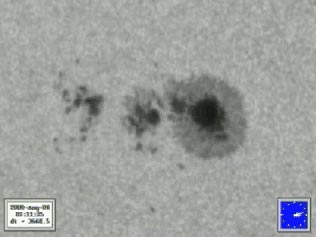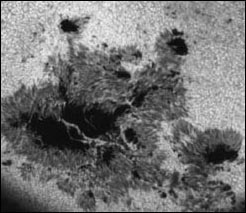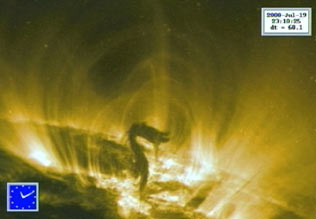 |
| A
video clip of a sunspot moving across the
surface of the Sun. Sunspots can be up to
several times larger than the diameter of
the Earth.
(Click
to launch movie.)
|
|
|
Believe it or not, although you cannot
hold a piece of the Sun in your hand, you can explore a model
of the forces that control most of its active surface. The
Sun has a magnetic personality.
Magnetic Mystery
For over 100 years, astronomers
have known from direct observations that the Sun's surface
has a magnetic field that is about twice as strong as Earth's,
but spread out over 10,000 times the area. We don't exactly
know where it comes from. It may have been left over from
the interstellar cloud that created the Sun over 4.5 billion
years ago. Some astronomers think it is actually generated
by the Sun itself.
Over all, the Sun's field looks
a lot like a bar magnet. It has a north and south polarity
as all magnets do. Much of its shape can be seen during a
total solar eclipse as it leaves an imprint on the Sun's outer
gases, just like iron filings outline the field of a bar magnet.
But there is more to the Sun's magnetism than what you might
find by just looking at a bar magnet.
 |
| While
Sunspots are only moderately cooler they are considerably
darker as this image from the Big Bear Observatory
shows.
|
|
Sunspots have been observed from
Earth by ancient Chinese astronomers for over 4000 years,
but only in the last 200 years have astronomers begun to figure
out just what they are. Sunspots are actually intense concentrations
of magnetic energy nearly 4000 times stronger than Earth's
own field, stronger than the rest of the Sun's. Somewhere
within the Sun's convective zone, perhaps where it bumps up
against the deeper radiative zone, conditions are just right
for creating jet streams of flowing currents. These currents
create ropes of magnetism, which can get concentrated by convective
gas flows. When they reach the surface, they pop through and
form pairs of sunspots.
Opposites Attract
Sunspots have a tendency to occur
in pairs or more complex groups. When they occur in pairs,
one sunspot always has the opposite magnetic polarity of the
other, and they usually follow each other around the surface
of the rotating Sun. This is why the magnetic field of a sunspot
pair often looks like a bar magnet, although on a scale billions
of times larger than in your classroom. The gases in the centers
of sunspots have temperatures of about 3000 Centigrade. They
appear dark because of their contrast with the rest of the
solar surface which is at a temperature of about 5700 Centigrade.
 |
| Magnetic
"loops" as seen here demonstrate
the intense magnetism exhibited near sunspot
areas. This video was taken by the NASA TRACE
spacecraft.
(Click
to launch movie.)
|
|
|
 Find
out more about the Sun-Earth Connection at the Sun-Earth
Connection Education Forum Web site.
Find
out more about the Sun-Earth Connection at the Sun-Earth
Connection Education Forum Web site.
Text adapted from the
Sun-Earth Connection Tutorial courtesy of NASA, originally
written by Dr. Sten Odenwald. Images and videos courtesy of
NASA unless otherwised noted.
|